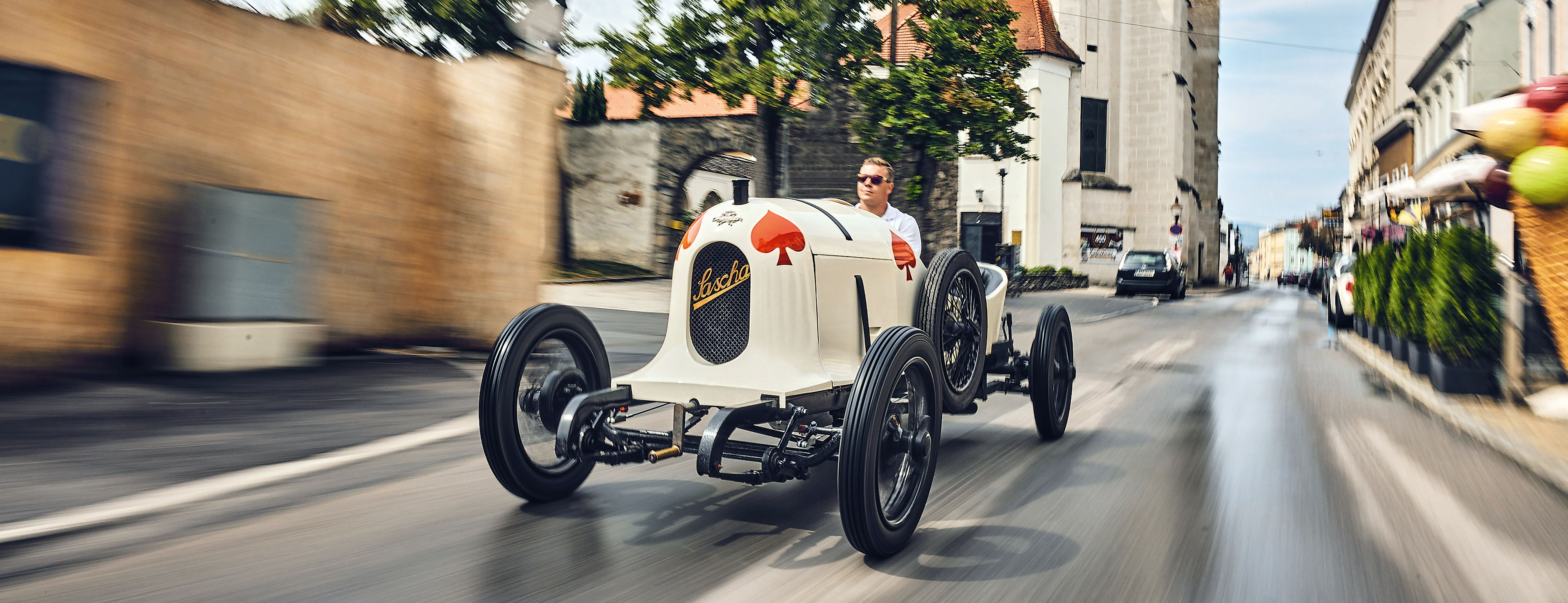
Homecoming
Sascha and its creators
One of the four Sascha prototypes at the Riesrennen race in Graz, Austria, in 1922. To the left of the car is Alexander Graf Kolowrat, to the right a young Ferry
Back to the roots: more than a hundred years ago, Ferdinand
Following a vigorous turn of the crank, the gas pedal is applied ever so gently, producing the sound that everyone’s been waiting for. Passersby reach for their smartphones, cafe owners step out onto their terraces, and curious faces appear in the windows of the old, historical buildings. Everyone knows that’s not the roar of an everyday car. And they’re right! The powerful litany of sounds stems from the water-cooled 1.1-liter four-cylinder engine of an Austro-Daimler ADS-R, a race car designed by Ferdinand
![[+]](https://files.porsche.com/filestore/image/multimedia/none/christophorus-issue409-article01-content-01/normal/2df6933f-7ee4-11ee-810c-005056bbdc38/porsche-normal.jpg)
Journey through time
Jan Heidak, vehicle service attendant at the
The visionary’s dream
A drive on gravel
During the training for the Riederberg race in Lower Austria, Graf Kolowrat drove one of the four prototypes himself.
Ferdinand
Premiere in Sicily
The Austro-Daimler ADS-R at
Of the three that competed in the 1.1‑liter class, one, driven by Kolowrat himself, had to drop out due to engine issues and the other two both secured a 1-2 victory in the class. Equipped with a 1.5-liter engine, the fourth Sascha race car went up against the competition in the stronger, open class and, after 432 kilometers, 6,000 turns, and gradients of up to 12.5 percent, secured 19th place in the overall ranking – with a top speed of 144 kmh. The Italian press hailed the ADS-R as “the revelation of the
![[+]](https://files.porsche.com/filestore/image/multimedia/none/christophorus-issue409-article01-content-02/normal/973d0f30-7ee8-11ee-810c-005056bbdc38/porsche-normal.jpg)
More than a hundred years later, Sascha still cuts a fine figure with the wooden toolbox at the rear here in Wiener Neustadt.
Finally home
Pit lane
Alfred Neubauer and mechanic Georg Auer raced Sascha on the Austro‑Daimler test track in 1922.
Back to Wiener Neustadt in 2023. Many buildings on the sun-filled Herrengasse are protected as historical monuments, some of which go back to the Middle Ages. Jan Heidak applies the gas pedal and – after more than a hundred years – Sascha’s wheels begin to turn again. It cruises the streets of the old town, circles the late-Romanesque cathedral, and rolls through the gate of the 13th-century Reckturm tower. This is roughly what it must have looked like when the people of Wiener Neustadt had the pleasure of seeing it drive by all those years ago. While many of the
Today, Heidak is the only one who knows how it feels to drive the race car. “Sascha was built for other road surfaces. We actually have too much grip, are too fast, and have high forces,” he explains during a break. “But it’s still a lot of fun. You can feel every vibration. Hear how the engine’s performing. There’s no power steering, so you need a lot of strength and sensitivity.” Goggles are also a definite must as the front wheels throw up dust off the road. But Heidak enjoys all of that. “And it’s an absolute honor to drive through this scenery.”
Learning from Ferdinand Porsche
Jan Heidak and Kuno Werner
get the in-line four-cylinder engine up and running again.
He then hops back into the race car. There’s no seat belt, no lights. There’s an emergency seat for the mechanic next to the driver’s seat, which was common in race cars at that time. The pedals are also unusual: the clutch is on the left, the brake on the right, and the gas in the middle. “We didn’t realize just how much there was to understand about Sascha until we got started on the project,” explains Workshop Manager Kuno Werner. “When we were working on the powertrain, we had to think like the designers did back then.” There are more than 700 historical vehicles at the
Rebirth is only the beginning
Successful test-drive
After two days in Wiener Neustadt, Jan Heidak and Kuno Werner take stock. Sascha still runs as smoothly today as it did more than a hundred years ago.
It’s afternoon, and suddenly the car won’t start. Cranking, pushing – nothing helps. A nervous energy takes hold of the team. Except for Werner and Heidak. With very few words exchanged between them, they get to work. They know exactly what they’re doing. And not even 15 minutes later, we hear the now-familiar sound of the race car. “We had to replace a spark plug,” explains Werner. “It’s completely normal for something like that to happen when you’re driving such an old car. We were expecting that.” Werner himself is proof that you never stop learning. He has been with
The 29-year-old goes for one last drive – through Burggasse and alongside the historic city wall. Kuno Werner stands at the edge of the street with a satisfied smile on his face. “Bringing Sascha back home was a team effort and quite an achievement,” he says. Restoration was a mammoth project requiring the help of Weissach Development Centre employees, retired employees, and external service providers. “But that was just the beginning,” says Werner. The idea is to continue incorporating Sascha into the company’s activities, with authentic reports about the roots of
![[+]](https://files.porsche.com/filestore/image/multimedia/none/christophorus-issue409-article01-content-03/normal/7fc0db88-7eeb-11ee-810c-005056bbdc38/porsche-normal.jpg)
Jan Heidak follows in Graf Kolowrat’s footsteps, seen here in the Wiener Neustadt Academy Park.
By Matthias Kriegel
Photos by Heiko Simayer
![[+]](https://files.porsche.com/filestore/image/multimedia/none/christophorus-issue409-article01-margin-01/normal/200ac2cb-7ee0-11ee-810c-005056bbdc38/porsche-normal.jpg)
![[+]](https://files.porsche.com/filestore/image/multimedia/none/christophorus-issue409-article01-margin-02/normal/c6c2e6a1-7ee5-11ee-810c-005056bbdc38/porsche-normal.jpg)
![[+]](https://files.porsche.com/filestore/image/multimedia/none/christophorus-issue409-article01-margin-03/normal/aa1ccc00-7ee7-11ee-810c-005056bbdc38/porsche-normal.jpg)
![[+]](https://files.porsche.com/filestore/image/multimedia/none/christophorus-issue409-article01-margin-04/normal/dbd5c89b-7ee9-11ee-810c-005056bbdc38/porsche-normal.jpg)
![[+]](https://files.porsche.com/filestore/image/multimedia/none/christophorus-issue409-article01-margin-05/normal/ef444c5e-7eea-11ee-810c-005056bbdc38/porsche-normal.jpg)
![[+]](https://files.porsche.com/filestore/image/multimedia/none/christophorus-issue409-article01-margin-06/normal/721aa7bc-7eec-11ee-810c-005056bbdc38/porsche-normal.jpg)